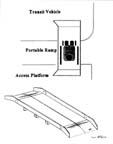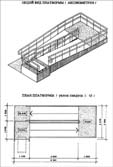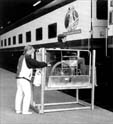
Mobility for all
Getting on board
by Tom Rickert
Entire guide as a PDF file (1.43 MB)
Low-floor buses: Easy access for everybody
Low-floor buses are becoming a common sight in Europe and North America. Many low-floor buses can board wheelchair users directly from a raised sidewalk. Others use a foldout ramp, such as the Canadian bus in the photo shown at left. And other low-floor buses use a sliding ramp under the floor, as with the bus in London shown at right.


Wheelchair securement: U.S. & European methods
In the United States, passengers using wheelchairs usually face forward, the wheelchair is secured using a wheel clamp or belt, and the passenger is secured with a seat belt (photo at left). In Europe, wheelchair users travel unrestrained, seated facing backward, with the wheelchair backed against a soft bulkhead.



Bus access to key sites
In countries, which lack accessible buses, access for passengers who cannot climb steps may be possible using platforms at key sites. As proposed by AEI, a portable bridge piece, fixed to the platform or stored behind the driver inside the bus, can span the gap between a raised platform and the floor of the bus. A bridge design prepared by Kevin Ball and Trent Inglesby at Oregon State University (USA) is shown in the diagrams above at left, while a prototype platform designed by Angela Archangelskaya in Moscow is shown in the middle. The photo at right show testing of ramped platforms with buses in the USA. If properly located, a network of such platforms could provide significant access at low cost, depending on local conditions.




Access to trains and subways
Access by persons with disabilities to trains and subways are another important part of creating accessible public transportation.
Advocates should stress the importance of building new railway cars with doors wide enough to accommodate those using wheel-chairs, walkers, and other mobility devices. Once inside, design features should allow room for those riding wheelchairs either to remain in their wheelchairs or to transfer to a regular seat. In general, the various features noted in the discussion on access to buses also apply to access to trains. However, access to trains is simplified by two differences:
1) There are fewer train stations because they are usually farther apart than bus stops.
2) It is usually necessary to provide wheelchair access on only one car per train.
There are two general methods of providing access to trains from platforms, although each method has several variants. Both methods are used extensively in North America and Europe:
1) Through the use of portable hand-operated lifts, illustrated in the Canadian photo, upper left.
2) Through the use of high platforms, which permit all passengers to board on a level surface, as shown in the American photo in the left middle.
The diagram at right middle illustrates the use of a warning strip to assist all passengers near the edge of the platform. In many countries, this strip is approximately 24 inches (approx. 600 mm) wide. The warning strip should provide a difference in color (typically a bright yellow), texture and "feel" (the warning strip should feel different under foot, or at the touch of a cane used by a blind person). The diagram also illustrates how flat level crossings should be provided if tracks must be crossed to get to the proper platform.
Access to railroad platforms can vary between stations or between different cities and countries. The upper right photo illustrates the use of a ramp to provide access for wheelchair users and other passengers to a subway platform in San Francisco. However, many subway stations are far below ground and require the construction of elevators to the platform level in order to provide access for persons with disabilities. In such cases, key stations should be identified in cooperation with advisors with disabilities, in order to phase in such improvements. In all events, new subway and railway stations around the world should always be built to permit access by passengers with disabilities. Such construction almost always costs far less than retrofitting older stations. In fact, there is often little or no additional cost when new facilities are built with full access for frail elders and persons with disabilities.